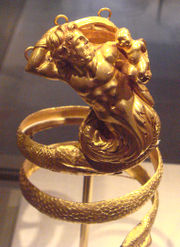Triton (mythology)
| Greek deities series |
|
|---|---|
| Primordial deities | |
| Titans and Olympians | |
| Chthonic deities | |
| Personified concepts | |
| Other deities | |
| Aquatic deities | |
|
|
Triton (Τρίτων, gen: Τρίτωνος) is a mythological Greek god, the messenger of the sea. He is the son of Poseidon, god of the sea, and Amphitrite, goddess of the sea, whose herald he is. He is usually represented as a merman, having the upper body of a human and the tail of a fish, "sea-hued", according to Ovid[1] "his shoulders barnacled with sea-shells".
Like his father, Poseidon, he carried a trident. However, Triton's special attribute was a twisted conch shell, on which he blew like a trumpet to calm or raise the waves. Its sound was so terrible, that when loudly blown, it put the giants to flight, who imagined it to be the roar of a mighty wild beast.[2]
According to Hesiod's Theogony,[3] Triton dwelt with his parents in a golden palace in the depths of the sea; Homer places his seat in the waters off Aegae.[4]. The story of the Argonauts places his home on the coast of Libya. When the Argo was driven ashore in the Gulf of Syrtes Minor, the crew carried the vessel to the "Tritonian Lake", Lake Tritonis, whence Triton, the local deity euhemeristically rationalized by Diodorus Siculus as "then ruler over Libya",[5] welcomed them with a guest-gift of a clod of earth and guided them through the lake's marshy outlet back to the Mediterranean.[6]
Triton was the father of Pallas and foster parent to the goddess Athena.[7] Pallas was killed by Athena during a fight between the two goddesses.[8] Triton is also sometimes cited as the father of Scylla by Lamia. Triton can sometimes be multiplied into a host of Tritones, daimones of the sea.

Contents |
Tritones
Over time, Triton's name and image came to be associated with a class of merman-like creatures, the Tritones, which could be male or female, and usually formed the escort of marine divinities. Ordinary Tritons were described in detail by the traveller Pausanias (ix. 21).[9]
When Pausanias visited the city of Triteia in the second century CE, he was told that the name of the city was derived from an eponymous Triteia, a daughter of Triton, and that it claimed to have been founded by her son (with Ares), one among several mythic heroes named Melanippus ("Black Horse").[10]
Triton since the Renaissance
The largest moon of the planet Neptune has been given the name Triton, as Neptune is the Roman equivalent of Poseidon.
In Wordsworth's sonnet "The World Is Too Much with Us" (ca 1802, published 1807), the poet regrets the prosaic humdrum modern world, yearning for
glimpses that would make me less forlorn;
Have sight of Proteus rising from the sea;
Or hear old Triton blow his wreathèd horn.
A family of large sea snails, the shells of some of which have been used as trumpets since antiquity, are commonly known as "tritons", see Triton (gastropod).
The name Triton is associated in modern industry with tough hard-wearing machines such as the Ford Triton engine and Mitsubishi Triton pickup truck.
The mascot of the University of California, San Diego is the Triton.
In fiction
Triton appears in The Last Olympian by Rick Riordan. He helps his father fight against the Titans of the sea, and is very rude to Percy Jackson, who is his half brother. In the book he is described as a young-looking merman with two fish tails instead of one, green skin, black hair tied into a ponytail, and wearing armor studded with pearls.
King Triton, as an adaptation, also stars in the Disney animated film The Little Mermaid (1989) as Sea King and ruler of "Atlantica".
Triton appears in the film Jason and the Argonauts (film) (1968). He holds back the base of rocks in a strait that just sunk another ship, thus allowing the Argo to continue on its journey.
Triton also appears as a villain in the DC Comics books Aquaman and Wonder Woman.[11]
In the PlayStation Portable game God of War: Chains of Olympus, the prequel to a series of games based on Greek mythology, a statue of Triton is seen in the Caves of Olympus. The protagonist Kratos takes Triton's Lance so Kratos can swim and breathe underwater for unlimited amounts of time.
In a new SpongeBob SquarePants special, Spongebob releases him from a cage and Triton attacks Bikini Bottom.
References
- ↑ Ovid, Metamorphoses I.332 ff.
- ↑ Pseudo-Hyginus, Poetical astronomy ii. 23
- ↑ Theogony 930.
- ↑ Iliad xiii. 20.
- ↑ Diodorus iv.56.6.
- ↑ Apollonius Rhodius, Argonautica, iv. 1552ff
- ↑ Pseudo-Apollodorus, Bibliotheke 3. 144.
- ↑ Apollodorus: Bibliotheca, 3.12.3
- ↑ Pausanius, Description of Greece 9.21.2: "The Tritons have the following appearance. On their heads they grow hair like that of marsh frogs not only in color, but also in the impossibility of separating one hair from another. The rest of their body is rough with fine scales just as is the shark. Under their ears they have gills and a man's nose; but the mouth is broader and the teeth are those of a beast. Their eyes seem to me blue, and they have hands, fingers, and nails like the shells of the murex. Under the breast and belly is a tail like a dolphin's instead of feet."
- ↑ Pausanias, Description of Greece vii.22.8.
- ↑ Aquaman Annual #1 and Wonder Woman (vol. 2) #162-163
External links
- Nereid and Triton Mosaic from Ephesus Terrace Home -2
- 3D stereoview of Nereid and Triton relief from Apollon Temple in Didim
- TheoiProject: Triton Classical references to Triton in English translation